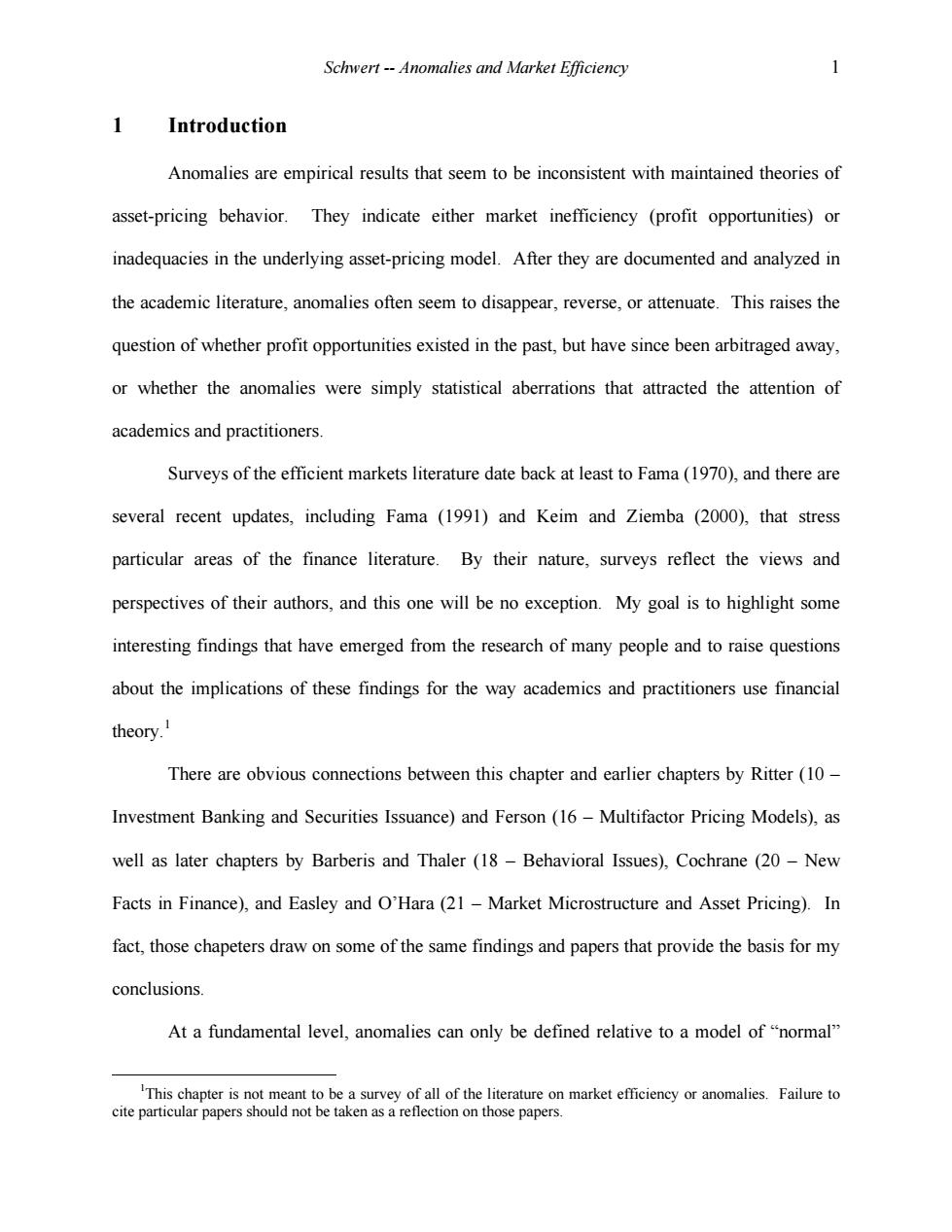正在加载图片...

Schwert--Anomalies and Market Efficiency 1 Introduction Anomalies are empirical results that seem to be inconsistent with maintained theories of asset-pricing behavior.They indicate either market inefficiency (profit opportunities)or inadequacies in the underlying asset-pricing model.After they are documented and analyzed in the academic literature,anomalies often seem to disappear,reverse,or attenuate.This raises the question of whether profit opportunities existed in the past,but have since been arbitraged away, or whether the anomalies were simply statistical aberrations that attracted the attention of academics and practitioners. Surveys of the efficient markets literature date back at least to Fama(1970),and there are several recent updates,including Fama (1991)and Keim and Ziemba (2000),that stress particular areas of the finance literature.By their nature,surveys reflect the views and perspectives of their authors,and this one will be no exception.My goal is to highlight some interesting findings that have emerged from the research of many people and to raise questions about the implications of these findings for the way academics and practitioners use financial theory.I There are obvious connections between this chapter and earlier chapters by Ritter(10- Investment Banking and Securities Issuance)and Ferson (16-Multifactor Pricing Models),as well as later chapters by Barberis and Thaler (18-Behavioral Issues),Cochrane (20-New Facts in Finance),and Easley and O'Hara(21-Market Microstructure and Asset Pricing).In fact,those chapeters draw on some of the same findings and papers that provide the basis for my conclusions. At a fundamental level,anomalies can only be defined relative to a model of"normal" This chapter is not meant to be a survey of all of the literature on market efficiency or anomalies.Failure to cite particular papers should not be taken as a reflection on those papers.Schwert -- Anomalies and Market Efficiency 1 1 Introduction Anomalies are empirical results that seem to be inconsistent with maintained theories of asset-pricing behavior. They indicate either market inefficiency (profit opportunities) or inadequacies in the underlying asset-pricing model. After they are documented and analyzed in the academic literature, anomalies often seem to disappear, reverse, or attenuate. This raises the question of whether profit opportunities existed in the past, but have since been arbitraged away, or whether the anomalies were simply statistical aberrations that attracted the attention of academics and practitioners. Surveys of the efficient markets literature date back at least to Fama (1970), and there are several recent updates, including Fama (1991) and Keim and Ziemba (2000), that stress particular areas of the finance literature. By their nature, surveys reflect the views and perspectives of their authors, and this one will be no exception. My goal is to highlight some interesting findings that have emerged from the research of many people and to raise questions about the implications of these findings for the way academics and practitioners use financial theory.1 There are obvious connections between this chapter and earlier chapters by Ritter (10 – Investment Banking and Securities Issuance) and Ferson (16 – Multifactor Pricing Models), as well as later chapters by Barberis and Thaler (18 – Behavioral Issues), Cochrane (20 – New Facts in Finance), and Easley and O’Hara (21 – Market Microstructure and Asset Pricing). In fact, those chapeters draw on some of the same findings and papers that provide the basis for my conclusions. At a fundamental level, anomalies can only be defined relative to a model of “normal” 1This chapter is not meant to be a survey of all of the literature on market efficiency or anomalies. Failure to cite particular papers should not be taken as a reflection on those papers